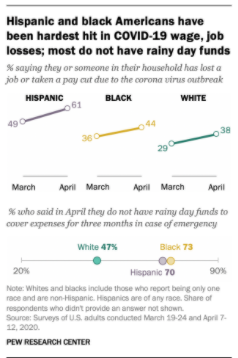By Olivia Schmid | | Layout Assistant
In 2020, we saw some of the greatest efforts made to address the need for social justice; however, it’s 2021 and the fight is not over. I published an article not too long ago about wage discrimination, but it is important to remember that a new year does not mean that the fight for equality (in any aspect) is over… and neither is COVID-19.
While eliminating the wage gap should be a priority in a world without a global pandemic, people are suffering in unimaginable ways right now, and being paid fairly should absolutely not be an additional concern for them.
Imagine what equal pay for equal work could look like. Imagine how being paid for their work in its entirety could help raise our marginalized communities in a time where they face so much oppression due to racism and consequences due to white privilege on top of the racial and gender wage gap.
This issue is even more relevant now that we are almost at the one-year mark of the Coronavirus pandemic.

The Pew Research Center argues that the impacts COVID-19 has on one’s financial status and health vary remarkably by race and ethnicity. How much would a more intentional fight for equal pay for equal work help communities? The possibilities are endless.
According to the US Census Bureau, white women who are equally qualified and working the same amount of time at the same job as their white male counterparts earn 98 cents to every white man’s dollar. Even still, individuals argue that the difference in pay isn’t a “big deal” or that it “doesn’t amount to much,” but I would argue that a difference in pay IS, indeed, a difference in pay.
While it is accurate to say that the difference between the earnings of men and women has shrunk over the years, it is crucial to understand that it hasn’t been by more than an incremental amount, and not even annually; some years, like 2020, there is no change at all.
And, if you’re okay with the slow rate of change, then that’s cool. At the current rate, we’ll reach equal pay for equal work by 2059 according to the Compensation Best Practices Report done by PayScale.
With 38 years before the gap theoretically closes over time, that means women will lose around $431,000 over a 40-year career due to the fact that they aren’t paid the same as white men from the start. Keep in mind this is even worse for people, especially women, of color.
…and for no attributable reason.
In response to learning that the gap has closed by one cent (yes, one whole cent!), Emily Martin, Vice President of education and workplace justice for the National Women’s Law Center, stated, “It’s outrageous that Black women and Latinas only scored a single penny raise last year [2019]…At this moment of a pandemic and a recession, it’s especially bitter news for these women who are shortchanged the most.”
What do we say to the women in these communities? Congrats, you scored a penny?
Come on now.
We live in the 21st century; equality, in ANY form, should not be rocket science. However, along with the idea of learning to be anti-racist, wearing a mask in a global pandemic, and supporting our LGBTQ+ community, wage discrimination is something that not everyone recognizes and some still consider controversial.
This is our world, plagued by racism and sexism. We need to do better.
First-year Olivia Schmid is a layout assistant. Her email is oschmid@fandm.edu.